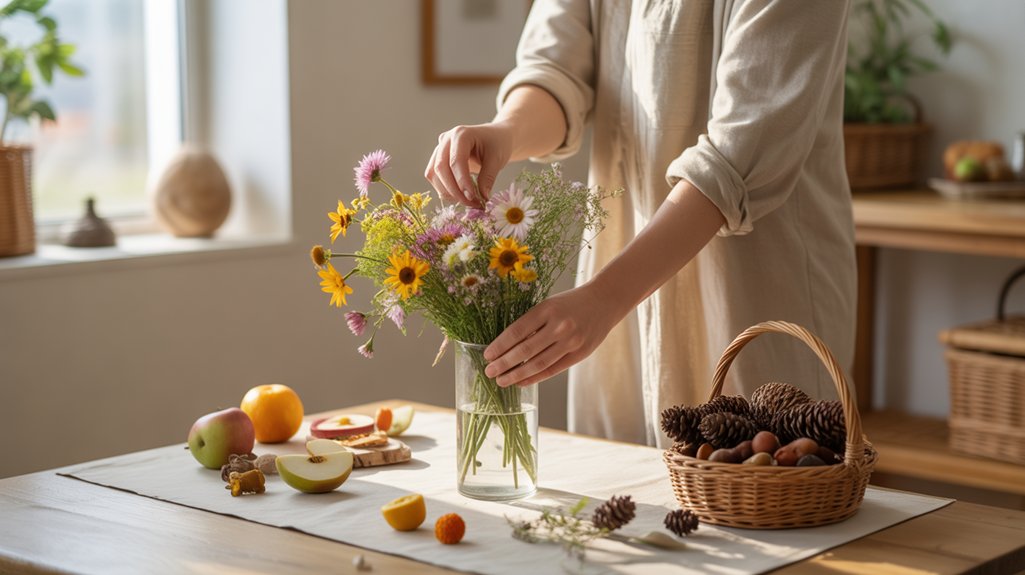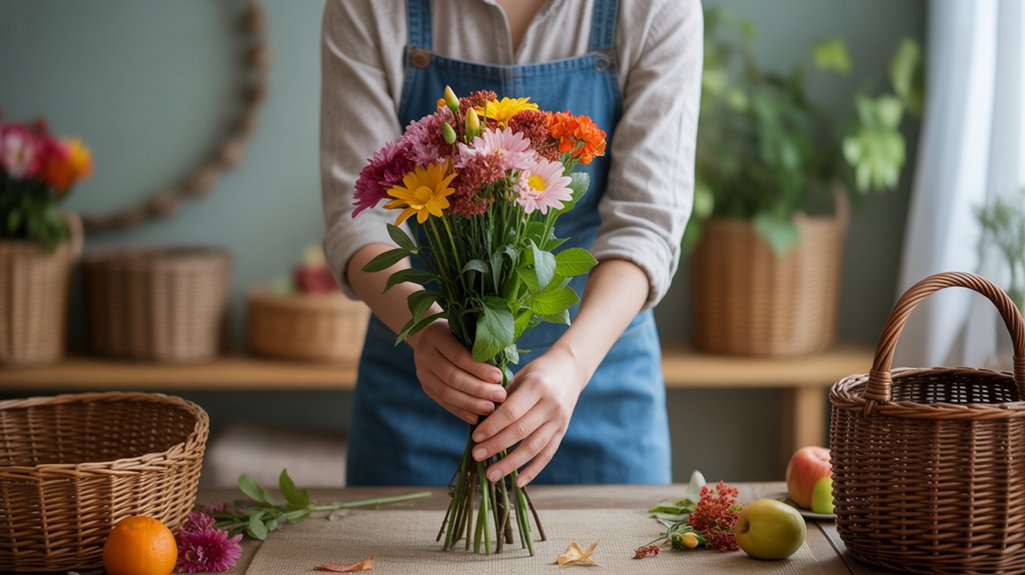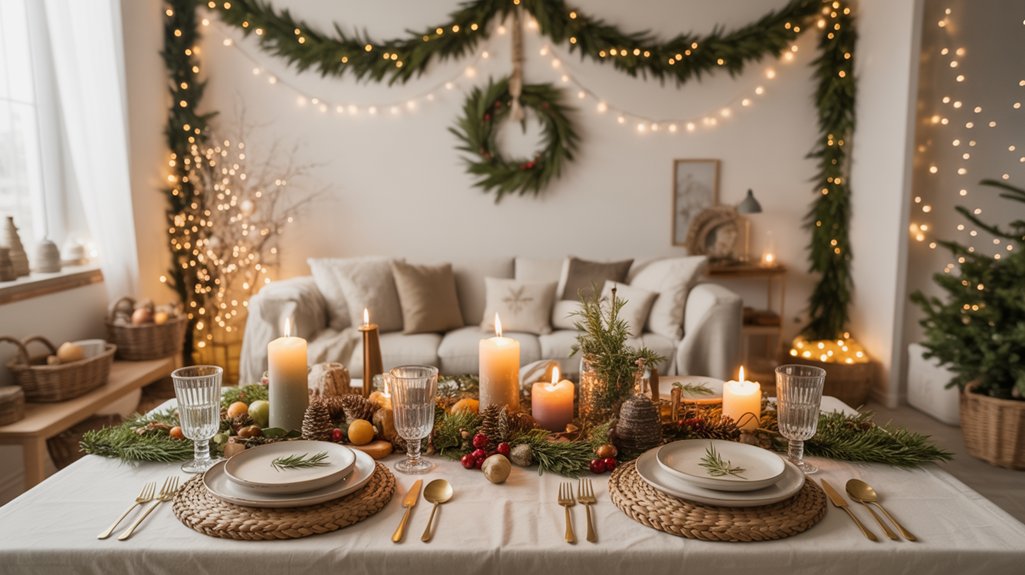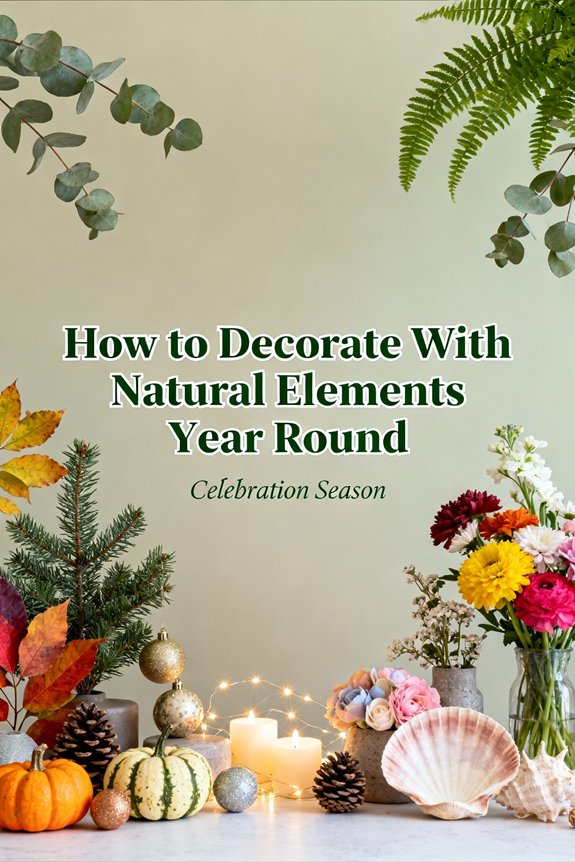Start by establishing foundational elements like reclaimed wood flooring and stone accent walls that provide year-round texture. Layer in living plants strategically placed at varying heights to create visual rhythm and improve air quality. Rotate seasonal botanicals—spring branches, autumn wheat, winter evergreens—while maintaining core pieces like stone vessels for consistency. Preserve collected materials through proper drying and sealing techniques to extend their display life. Master the balance between permanent structural elements and changeable accents to keep your spaces vibrant yet cohesive throughout every season's shift.
Key Takeaways
- Establish timeless foundations using reclaimed wood, stone installations, and natural textiles that provide consistency across all seasons.
- Rotate seasonal botanicals like spring blossoms and autumn branches while maintaining year-round anchor pieces such as stone vessels.
- Properly preserve natural materials through air drying, pressing, and wood treatments to ensure longevity and aesthetic integrity.
- Position living plants strategically at varying heights to create visual rhythm while improving air quality throughout the year.
- Store off-season elements in labeled containers after proper preservation, enabling thoughtful seasonal edits rather than dramatic transformations.
Sourcing Natural Materials From Your Local Environment

Before purchasing expensive decorative materials, scout your immediate surroundings for design-worthy natural elements that'll ground your space in regional character. Your neighborhood offers authentic textures that connect your home to its landscape—fallen branches, interesting stones, or seasonal foliage create installations that resonate with local identity.
Master basic foraging tips before you begin: collect only from abundant sources, avoid protected species, and gather responsibly without damaging living plants. Take pruning shears for clean cuts and baskets to transport delicate specimens safely.
Forage thoughtfully from abundant sources with proper tools—pruning shears and baskets—while protecting living plants and respecting protected species in your area.
Establish relationships with local suppliers who understand your region's botanical palette. Visit farmers' markets, nurseries, and botanical gardens for dried grasses, seed pods, and branches they'd otherwise discard. These connections provide sustainable access to materials while supporting your community's green spaces.
Consider spatial relationships when displaying finds—cluster smaller elements for impact, use vertical branches to draw the eye upward, and arrange collections by color or texture for visual coherence. As seasons change throughout the year, rotate your natural displays to reflect holiday celebrations and parties or simply honor the shifting landscape outside your windows.
Preserving and Preparing Natural Elements for Long-Term Display
Once you've gathered natural materials from your surroundings, proper preservation becomes crucial to maintain their aesthetic integrity within your interior spaces.
Without appropriate treatment, organic elements deteriorate rapidly, compromising both visual appeal and structural stability in your design compositions.
Mastering drying techniques for botanicals, wood treatment methods, and protective finishes guarantees your natural décor elements remain beautiful focal points for extended periods.
Drying Techniques for Botanicals
Fresh botanicals convert into enduring decorative elements when you apply proper drying methods that preserve their structural integrity and visual appeal.
Air drying works exceptionally well for sturdy stems like eucalyptus, lavender, and hydrangeas—simply bundle stems together and suspend them upside down in a dark, well-ventilated space for two to three weeks. This technique maintains dimensional form while concentrating natural pigments.
Pressing flowers suits delicate specimens such as pansies, ferns, and Queen Anne's lace, creating flat botanical art perfect for frames or shadow boxes. Layer your specimens between absorbent paper, apply consistent weight, and allow four weeks for complete moisture removal.
Both methods honor the organic beauty you're bringing into your space while creating lasting connections to nature's seasonal rhythms.
Natural Wood Treatment Methods
Raw wood pieces convert into polished decorative elements through three fundamental treatment processes that improve durability while showcasing natural grain patterns.
You'll find sanding creates smooth surfaces that accept finishes uniformly, starting with coarse grits and progressing to fine ones.
Wood treatment techniques include sealing with natural oils like linseed or tung oil, which penetrate deeply to protect against moisture while maintaining breathability. Eco friendly finishes such as beeswax polish add subtle luster without toxic chemicals, perfect for creating cohesive room aesthetics.
Alternatively, you can apply water-based polyurethane for high-traffic display pieces requiring extra protection. Each method preserves the organic character your space deserves while extending longevity.
Consider your room's humidity levels and piece placement when selecting treatments, ensuring your natural elements remain beautiful focal points throughout seasons.
Sealing and Protective Finishes
Before natural elements can withstand years of display, they'll need appropriate protective barriers that shield against environmental degradation while maintaining visual authenticity. Your sealing techniques should complement each material's inherent characteristics while preventing moisture damage, insect infiltration, and UV deterioration.
Select protective coatings based on your display environment and material porosity:
| Material Type | Recommended Finish |
|---|---|
| Driftwood & Branches | Matte polyurethane or tung oil |
| Dried Botanicals | Clear acrylic spray sealer |
| Natural Stone | Penetrating stone sealer |
Apply finishes in thin, even layers, allowing proper curing time between coats. Test products on inconspicuous areas first to verify compatibility. Consider your room's humidity levels when determining finish thickness—high-moisture spaces require additional protective layers for longevity within your thoughtfully curated natural displays.
Creating a Foundation With Wood, Stone, and Organic Textures
Natural materials establish the structural backbone of biophilic design, grounding your space in tactile authenticity. Your wood selection and stone variety choices create visual weight that anchors rooms while connecting inhabitants to nature's inherent patterns.
Strategic placement of foundational elements alters ordinary interiors into sensory-rich environments:
- Reclaimed wood beams expose centuries of grain patterns, celebrating material history
- Limestone accent walls introduce subtle geological texture through neutral tonal variation
- Wide-plank flooring in oak or walnut establishes warmth underfoot
- River rock installations provide sculptural focal points with irregular organic forms
- Jute and sisal textiles layer additional depth through woven plant fibers
You'll find these materials work synergistically, each element enhancing the others through complementary textures and earth-derived color palettes.
Balance rough-hewn surfaces with refined finishes to maintain sophistication. These décor concepts work equally well for everyday living and when hosting gatherings throughout the year. By integrating these foundational components thoughtfully, you're crafting spaces that resonate with our collective desire for natural connection.
Incorporating Living Plants and Fresh Botanicals

While foundational materials provide structural authenticity, living plants introduce energetic importance that alters static interiors into breathing ecosystems.
You'll discover that strategic plant placement creates focal points while enhancing your home's spatial flow. Consider clustering specimens at varying heights to establish visual rhythm and depth.
Indoor gardening alters your approach to seasonal decoration. You're not simply adding accessories—you're cultivating relationships with living elements that evolve alongside your space.
Air purifying plants like pothos, snake plants, and peace lilies serve dual purposes, purifying your environment while contributing organic sculptural forms.
Fresh botanicals offer flexibility for those hesitant about long-term plant care. You can rotate seasonal branches, cut flowers, and foliage to reflect changing landscapes outside.
Display eucalyptus stems in minimal vessels, arrange seasonal branches in floor vases, or float blooms in shallow bowls. These choices connect you to nature's cycles while maintaining design cohesion throughout your home's architecture.
Styling Natural Elements for Different Rooms and Purposes
Each room in your home serves a distinct function and requires a tailored approach to natural decoration that improves both its purpose and atmosphere.
Living spaces and entryways benefit from statement pieces that create immediate impact and set the tone for your home's aesthetic, while bedrooms and bathrooms demand more intimate, sensory-focused arrangements that promote relaxation and well-being.
Understanding these spatial distinctions allows you to strategically position natural elements where they'll make the most meaningful contribution to each environment's character and usability.
Living Spaces and Entryways
As visitors cross your threshold, the entryway establishes your home's design narrative and sets expectations for the spaces beyond.
Strategic placement of natural elements alters these high-traffic zones into welcoming sanctuaries that balance entryway organization with aesthetic appeal.
Consider these design approaches for optimum impact:
- Position driftwood sculptures or stone arrangements on console tables to anchor the space
- Layer woven baskets beneath seating for practical storage that maintains organic warmth
- Enhance natural lighting by placing potted fiddle leaf figs or snake plants near windows
- Create seasonal vignettes with branches, dried florals, or collected botanicals
- Install floating shelves displaying curated collections of shells, minerals, or preserved specimens
Your living spaces benefit from similar integration, where natural textures soften hard surfaces while maintaining cohesive flow throughout adjoining rooms.
Bedrooms and Bathrooms
Private retreats demand a refined approach to natural elements, where restorative atmosphere takes precedence over visual impact alone.
You'll want to layer bedroom textiles thoughtfully—linen duvets, wool throws, and cotton sheeting create tactile comfort while maintaining organic authenticity. Consider dried eucalyptus bundles suspended above nightstands or weathered branches arranged in ceramic vessels to introduce vertical interest without overwhelming intimate quarters.
Your bathroom accents should embrace moisture-resistant materials: river stones as soap dishes, teak bath mats, and rattan storage baskets that withstand humidity while contributing warmth.
Stone vessels and bamboo accessories ground these spaces in natural simplicity. Focus on curating fewer, more intentional pieces rather than cluttering surfaces. This measured approach guarantees your private spaces feel cohesive with your home's broader design narrative while supporting the restorative function these rooms serve.
Rotating and Refreshing Your Natural Décor Through the Seasons

Natural décor thrives on strategic rotation that mirrors the earth's cyclical changes, allowing your space to maintain visual interest while honoring seasonal shifts.
Implementing seasonal swaps doesn't require complete overhauls—instead, focus on intentional updates that refresh your environment while maintaining cohesion.
Seasonal refreshes succeed through thoughtful edits rather than dramatic transformations—small, purposeful changes maintain harmony while renewing your space.
Create a rotation system using nature inspired themes that reflect each season's distinct character:
- Spring: Display cherry blossoms, pussy willows, and bird nests in soft pastels
- Summer: Incorporate seashells, driftwood, and fresh botanicals in vibrant greens
- Autumn: Feature dried wheat, pinecones, and branches with warm amber tones
- Winter: Arrange evergreen boughs, frosted pinecones, and birch bark in cool neutrals
- Year-round: Maintain foundational pieces like stone vessels and wooden platforms
Store off-season elements in labeled containers, ensuring they're properly dried and preserved.
This systematic approach keeps your décor feeling current while building a curated collection that deepens your connection to nature's rhythms throughout the year.
Frequently Asked Questions
How Do I Prevent Natural Elements From Attracting Insects Indoors?
You'll want to thoroughly dry and clean all natural elements before displaying them indoors.
Apply natural preservation techniques like sealing pine cones, pressing flowers completely flat, or treating wood with mineral oil.
Consider incorporating insect repellent plants like lavender and eucalyptus into your arrangements—they'll deter pests while enhancing your design's aesthetic.
Store seasonal pieces in airtight containers between uses, and regularly inspect your displays.
These practices guarantee your nature-inspired spaces remain both beautiful and pest-free throughout the year.
Can Natural Décor Work in Modern or Minimalist Interior Design Styles?
Natural décor absolutely complements modern and minimalist styles when you're thoughtful about selection and placement.
You'll want to choose pieces with clean lines and simple forms—think sculptural driftwood, smooth river stones, or single-stem branches.
These natural textures add warmth without cluttering your space. As minimalist accents, they create focal points that honor both design principles and your aesthetic vision.
You're joining a community that values intentional, curated spaces where less truly becomes more.
What's the Best Way to Clean Dust From Delicate Dried Botanicals?
For gentle cleaning of dried botanicals, you'll want to use a soft-bristle paintbrush or makeup brush for precise dust removal.
Alternatively, hold delicate stems away from your body and use your hairdryer's cool setting at low speed. This method works beautifully for pampas grass, dried florals, and preserved eucalyptus.
Never use water or cleaning solutions, as they'll compromise your botanicals' structural integrity.
Regular maintenance keeps your natural elements looking fresh and intentional within your curated space.
Are There Natural Elements Safe for Homes With Pets and Children?
Yes, you'll find plenty of pet-friendly materials and safe decorative options for your space.
Choose non-toxic botanicals like spider plants, Boston ferns, and bamboo stalks. Display smooth river stones, untreated wood pieces, and cork elements on higher surfaces.
Avoid toxic plants, small objects that pose choking hazards, and anything with sharp edges.
You're creating a welcoming environment where everyone thrives, so select natural elements that complement your design while prioritizing safety throughout your home.
How Do I Balance Natural Décor Without Making Spaces Look Cluttered?
You'll achieve balance through minimalist arrangements that follow the “rule of three”—grouping natural elements in odd numbers creates visual harmony without overwhelming your space.
Practice mindful placement by designating specific zones for décor, leaving negative space to let each piece breathe.
Rotate seasonal items rather than displaying everything simultaneously.
Consider scale carefully; one statement branch often makes more impact than multiple small accessories.
This curated approach guarantees your home feels intentionally designed, not accidentally cluttered.
Conclusion
You've now mastered the art of bringing the outdoors in, creating spaces that evolve naturally through every season. Studies show homes featuring natural elements can reduce stress levels by up to 15%, proving your design choices aren't just aesthetically pleasing—they're wellness investments. By thoughtfully sourcing, preserving, and rotating organic materials, you're cultivating environments that honor both spatial harmony and nature's rhythms. Your rooms will breathe with life, grounding your daily experience in authentic, sustainable beauty that never goes out of style.




